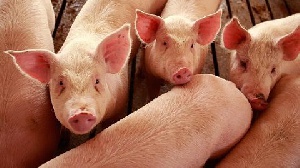BY CHRISTIAN AGUBRETU
Accra, Oct. 15, GNA - The National Planning Committee of this year's World Food Day, which falls on October 16, must be constrained indeed to find a venue to celebrate the Day so as to make it participatory and to bring the theme: Biodiversity for Food Security closer home to as many people as possible.
It is in the light of this that the activities to mark the Day have been moved from Accra to Bunso in the Eastern Region where there is the Plant Genetic Resource Centre under the Council for Scientific and Industrial Research (CSIR).
A member of the Planning Committee, Mr L.K Dzokoto, Director, Ministry of Food and Agriculture, is convinced that the Day, when celebrated at Bunso would bring the understanding of the theme to a broader spectrum of farmers, scientists, policy makers and the public to have a feel of biodiversity.
During one of the meetings of the Committee to fix a venue for the Day, Mr. Dzokoto said, "there is the need to bring the theme closer home to all stakeholders in agriculture and the food industry so that this year's World Food Day should not just be a flag raising and speech giving ceremony.
The flag raising ceremony, farmers' forum and a paper on the relevance of the theme would be held at Bunso.
With the Day being celebrated at Bunso it is expected that many visitors would interact with the experts and workers of the Plant Genetic Resource Centre established in 1964 for conservation of plant genetic resources, that is plant materials that benefit mankind. The Centre has a plantation of varieties of trees, crops and vegetables (arboretum) on a 16.4 hectares land with more than 600 medicinal plants and holds more than 8,400 accessions comprising vegetables, cereals, legumes, roots and tubers, spices, timber species, edible fruit trees and sweet berries (sweetnar).
It has provided training to more than 2,000 agricultural students in the nation's five Universities and other agriculture training colleges. Dr Lawrence Aboagye, Deputy Head of the Centre, told the Ghana News Agency that the Centre has farms with several types of local yams, water yams, varieties of local potatoes and many other local food crops, some of which are getting extinct.
The Centre, with its gene bank is able to conserve seeds and plants.
Farmers everywhere possess priceless local knowledge, including a highly tuned sense of how to match the right variety or breed with a particular agricultural ecosystem. In past years, the genetic resources of poor countries were used for crop and animal breeding, often with no benefit returning to those countries.
Today, the contribution of farmers in some countries is increasingly recognised along with their right to receive some of the benefits, including monetary benefits. The concept of Farmers' Rights holds that farmers should share in the benefits, have a voice in decision-making, enjoy continued access to genetic diversity and obtain protection of their traditional knowledge. Farmers' Rights is an essential part of the International Treaty on Plant Genetic Resources for Food and Agriculture, which came into effect in March this year. The Food and Agriculture Organisation (FAO} estimates that about three-quarters of the genetic diversity of agricultural crops have been lost over the last century. And out of 6,300 animal breeds, 1,350 are endangered or already extinct. Global efforts to conserve plants and animals in gene banks, botanical gardens and zoos are vital. But an equally important task is to maintain biodiversity on farms and in nature, where it can evolve and adapt to changing conditions or competition with other species.
As custodians of the world's biodiversity, farmers can develop and maintain local plans and trees and reproduce indigenous animals, ensuring their survival.
United Nations Environmental Programme (UNEP) in a book entitled Global Biodiversity Assessment said the three principal components of biodiversity (ecosystems, species, genes) are in common use today. According to United States Office of Technology Assessment (OTA 1987), these three major components of biodiversity are recognized and defined. "Biological diversity means a variability among living organisms from all sources, including inter alia, terrestrial, marine and other aquatic ecosystems and the ecological complexes of which they are part. These include diversity within species and between species of ecosystems.
The arboretum at Bunso harbours about 8,400 accessions: being plant species including legumes, herbs, insects, fruit trees and many organisms. Here farmers are taught how to preserve plant species and their conservation and how bio-diversity, a wide-range of topic influence the life of other organisms. There is some exotic tree species including eucalyptus and the monkey nut tree, which have its origin from the Amazon, Brazil. Its fruits are as large as cocoa nuts and when they are dried they explode at the bottom as if they have been cut with sharp knife. The seeds are good and contain Vitamin A and monkeys like them very much.
It is also at the arboretum where how human activities affect food we eat and what we have lost are shown. At the arboretum it is also shown how man is linked with nature and what unguarded human activities could do to destroy man's own survival.
Food security in its sense has a lot of meaning and implications while bio-diversity has perhaps a wider understanding so if you add bio-diversity to food security you may be entering into a wider world. It is said about 840 million people the world over are starving and half of the figure is in Africa
Invariably, farmers who have lived close to nature know by observation and experience what bio-diversity is. They may not know what the high scientific name bio-diversity is but they know that something influences their production, eating, farming, livelihood activities and their dependent on nature while they tilled the land, planted, harvested and fed themselves.
The activities of micro or macro organisms do not only influence our livelihood but also play a significant role and a far reaching role in agriculture production that would ensure food security.
FAO says it is to pay tribute to biodiversity's role in ensuring that people have regular access to enough high-quality food to lead active, healthy lives that is why it has chosen as its theme; "Biodiversity for Food Security" as this year's World Food Day. According to Dr Aboagye, food security should have sustainable relationship with the conservation of crops and plant species and if they were getting extinct attempts should be made to preserve them for posterity.
He said to have food security within biodiversity there was the need for farmers to do mixed-cropping because there were some crops, which were drought resistant and some were not and if any of the crops failed in any weather condition the farmer would have, at least, something to live on and would not go absolutely hungry.
With farming practices it was the type of mixed cropping that had saved Ghana for years but somewhere along the line mechanised farming with mono cropping surfaced as a way of achieving food security. Now the farmer is being asked to look back and pick the several advantages in mixed farming.
FAO says, "rather than a single crop variety that guarantees a high yield, farmers in developing countries are more likely to need an assortment of crops that grow well in harsh climates or animals with resistance to disease.
For the poorest farmers, the diversity of life may be their best protection against starvation." 11 Oct 04
General News of Saturday, 16 October 2004
Source: GNA
Biodiversity sends World Food Day to Bunso
Entertainment















